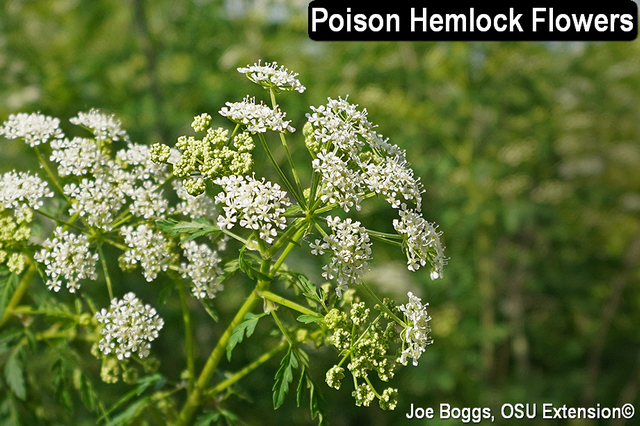By JAN LARSON McLAUGHLIN
BG Independent News
Poison hemlock – once an oddity in Ohio – has become a common threat across the state.
In Wood County, the plant is popping up along ditch banks, railroad tracks and even some lawns. It looks very similar to the benign Queen Anne’s Lace – but is one of the deadliest plants in North America, according to entomologists with OSU Extension.
“I’ve been seeing more and more and more of it every year,” primarily along railroads and ditches, said Adrien Lowien-Kirian, woodlands specialist with Wood County Park District.
“It’s pretty rare that I see it in the parks,” she said. “If I do, I remove it as soon as I see it.”
Neil Munger, director of the county park district, said his staff has reported seeing some hemlock along the Slippery Elm Trail – but they take care of it as soon as it’s spotted.
Lowien-Kirian described the poisonous hemlock as looking like “Queen Anne’s Lace – but on steroids.” The plant can grow at least 6 feet tall. It varies from Queen Anne’s Lace a bit, with it blossoming into several small flowers instead of large flowers, and having purple coloration on the stems.
“It’s definitely something you want to be careful around,” she said.
When removing it, Lowien-Kirian wears disposable gloves, pulls out the roots of the hemlock, and puts the plant in a garbage bag. Touching your eyes or an open cut after coming in contact with the toxic plant can cause serious respiratory problems.
Poisonous hemlock plants spread through seeds from the flowers.
“Usually you don’t notice you have it until it’s a problem,” she said.
Lowien-Kirian recommends using herbicides only if a property has a large infestation of the toxic plant.
Cinda Stutzman, natural resources specialist with Bowling Green City Parks, said this week that she double checked a questionable plant – but determined it was not hemlock.
“Still no poison hemlock in any BG city parks,” Stutzman said. “We monitor the preserve regularly and if it ever is found it will be immediately managed.”
People need to exercise caution anytime they come across a new plant or animal, Stutzman advised.
“There are many ways to figure out what you are seeing. Websites, apps, FB groups and local experts can all help point you in the right direction,” she said.
Craig Everett, a horticulturalist with Wood County OSU Extension, reminded that this is the same deadly plant that was used to kill Socrates.
“It’s a very toxic plant,” Everett said.
The purple blotchy stem is a “pretty dead giveaway” that the hemlock is not the harmless Queen Anne’s Lace.
It’s unlikely that the plant poses a threat to livestock, since farmers usually watch for such toxic plants, he said.
“Most livestock growers are aware of it,” Everett said.
The toxins affect people differently.
“Some people are more susceptible,” like with poison ivy, he said.
When removing hemlock, Everett recommends wearing gloves, a face shield, goggles and overalls if possible. Ideally, the plant should be placed in a plastic garbage bag that can be tied off.
“So the next person down the pipeline doesn’t get exposed to it,” he said.
Poison hemlock was imported into the U.S. as an ornamental plant in the late 1800s from Europe, West Asia and North Africa. Rogue plants remained relatively rare until around 30 years ago, according to Joe Boggs, who specializes in entomology with the OSU Extension Service.
The plant can be deadly if eaten.
All parts of the plant are poisonous: leaves, stems, seeds, and roots. However, the toxins must be ingested or enter through the eyes or nasal passages to induce poisoning. The toxins do not cause skin rashes or blistering.
Regardless, this plant should not be handled because sap on the skin can be rubbed into the eyes or accidentally ingested while handling food. Immediate emergency medical attention should be sought if an accidental poisoning from this plant is suspected.

